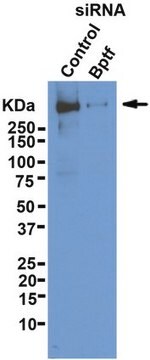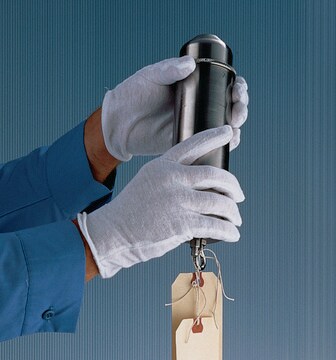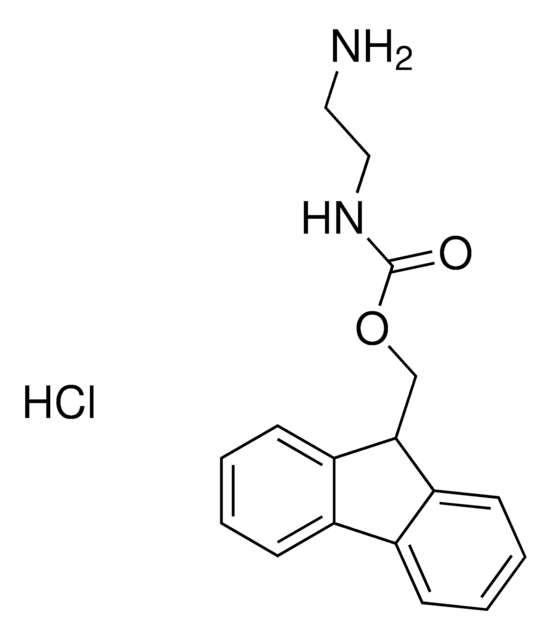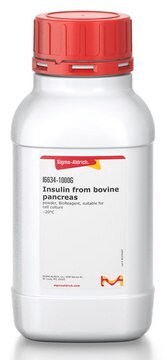일반 설명
Nucleosome-remodeling factor subunit BPTF (UniProt A2A654 and E9Q6A7; also known as Bromodomain and PHD finger-containing transcription factor, Fetal Alz-50 clone 1 protein, Fetal Alzheimer antigen) is encoded by the Bptf (also known as Fac1, Falz) gene (Gene ID 207165) in murine species. BPTF, SNF2L and pRBAP46/48 are the three subunits of the nucleosome-remodelling factor NURF, an ISWI chromatin-remodeling complex that catalyzes ATP-dependent nucleosome sliding. BPTF mediates NURF target site specificity via interactions with transcription factors, histone variants and histone modifications on transcriptionally active genes. BPTF plays an important role in regulating nucleosome occupancy at nucleosome-free regions (NFRs) at sites occupied by the multivalent factors CTCF and cohesin via direct interaction with CTCF and the cohesin subunit SA2. In addition, BPTF also interacts with c-MYC and plays an essential role in its genomic distribution and biological activity. BPTF is necessary for the survival of c-MYC-overexpressing cells and for c-MYC-driven tumorigenesis in the mouse pancreas. BPTF knockdown leads to decreased c-MYC chromatin accessibility and significantly delays tumour development in pre-neoplastic pancreatic acinar cells. Consistently, BPTF expression in human tumours positively correlates with activation of c-MYC gene signatures.
특이성
Specificity of this polyclonal antibody was confirmed by target band detection in wild-type, but not BPTF-knockout, mouse embryonic fibroblast (MEF) lysate (Courtesy of Joseph Landry, Ph.D, Virginia Commonwealth University School of Medicine).
면역원
MBP-tagged recombinant mouse BPTF fragment from the region between the third and fourth coiled coil.
애플리케이션
Anti-BPTF (VCU19) Antibody, Cat. No. ABE1966, is a highly specific rabbit polyclonal antibody that targets BPTF and has been tested in Chromatin Immunoprecipitation (ChIP), ChIP-seq and Western Blotting applications.
Chromatin Immunoprecipitation (ChIP) Analysis: A representative lot detected BPTF chromatin occupancy at known BPTF target sites by ChIP-PCR using mouse embryonic stem cell (mESC) chromatin preparation (Courtesy of Joseph Landry, Ph.D, Virginia Commonwealth University School of Medicine).
ChIP-seq Analysis: A representative lot mapped BPTF chomsome 19 enrichment sites by ChIP-seq analysis (Courtesy of Joseph Landry, Ph.D, Virginia Commonwealth University School of Medicine).
Chromatin Immunoprecipitation (ChIP) Analysis: A representative lot detected BPTF occupancy at Ctcf-targeted chromatin sites containing BPTF-dependent nucleosome-free regions (NFRs) using mouse embryonic stem cell (mESC) chromatin preparation (Qiu, Z., et al. (2015). Mol. Cell. Biol. 35(1):224-237).
Western Blotting Analysis: A 1:1,250 dilution from a representative lot detected BPTF in 50 µg of wild-type, but not BPTF-knockout, mouse embryonic fibroblast (MEF) lysate (Courtesy of Joseph Landry, Ph.D, Virginia Commonwealth University School of Medicine).
Research Category
Epigenetics & Nuclear Function
품질
Evaluated by Western Blotting in NIH/3T3 cell lysate.
Western Blotting Analysis: A 1:2,000 dilution of this antibody detected BPTF in 10 µg of NIH/3T3 cell lysate.
표적 설명
~300 kDa observed. 333.2/321.6 kDa (mouse; UniProt A2A654/E9Q6A7) and 338.3/325.1/322.2 kDa (human isoform 1/2/3; UniProt Q12830) calculated. Uncharacterized bands may be observed in some lysate(s).
물리적 형태
Affinity purified.
Purified rabbit polyclonal antibody in buffer containing 0.1 M Tris-Glycine (pH 7.4), 150 mM NaCl with 0.05% sodium azide.
저장 및 안정성
Stable for 1 year at 2-8°C from date of receipt.
기타 정보
Concentration: Please refer to lot specific datasheet.
면책조항
Unless otherwise stated in our catalog or other company documentation accompanying the product(s), our products are intended for research use only and are not to be used for any other purpose, which includes but is not limited to, unauthorized commercial uses, in vitro diagnostic uses, ex vivo or in vivo therapeutic uses or any type of consumption or application to humans or animals.

![3-[(2-Aminoethyl)amino]-1-propanol AldrichCPR](/deepweb/assets/sigmaaldrich/product/structures/193/734/c3b3e55a-2f61-43c5-8804-ff55209c4b55/640/c3b3e55a-2f61-43c5-8804-ff55209c4b55.png)







